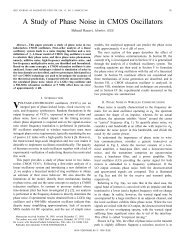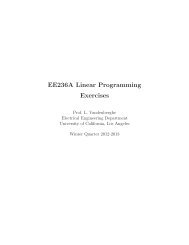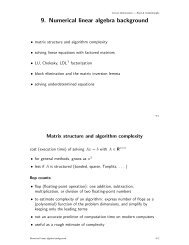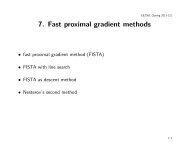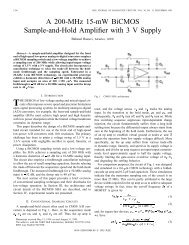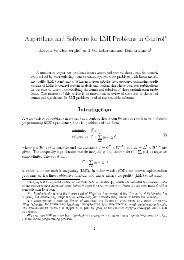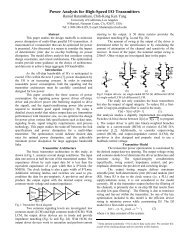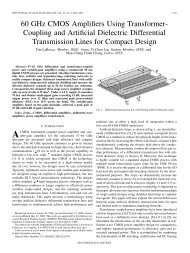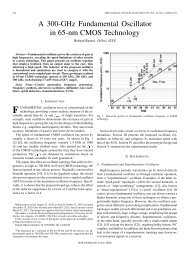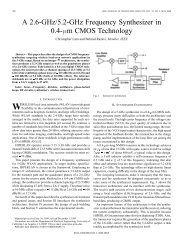2. Quasi-Newton methods
2. Quasi-Newton methods
2. Quasi-Newton methods
You also want an ePaper? Increase the reach of your titles
YUMPU automatically turns print PDFs into web optimized ePapers that Google loves.
• variable metric <strong>methods</strong><br />
• quasi-<strong>Newton</strong> <strong>methods</strong><br />
• BFGS update<br />
<strong>2.</strong> <strong>Quasi</strong>-<strong>Newton</strong> <strong>methods</strong><br />
• limited-memory quasi-<strong>Newton</strong> <strong>methods</strong><br />
EE236C (Spring 2011-12)<br />
2-1
<strong>Newton</strong> method for unconstrained minimization<br />
minimize f(x)<br />
f convex, twice continously differentiable<br />
<strong>Newton</strong> method<br />
x + = x−t∇ 2 f(x) −1 ∇f(x)<br />
• advantages: fast convergence, affine invariance<br />
• disadvantages: requires second derivatives, solution of linear equation<br />
can be too expensive for large scale applications<br />
<strong>Quasi</strong>-<strong>Newton</strong> <strong>methods</strong> 2-2
Variable metric <strong>methods</strong><br />
x + = x−tH −1 ∇f(x)<br />
H ≻ 0 is approximation of the Hessian at x, chosen to:<br />
• avoid calculation of second derivatives<br />
• simplify computation of search direction<br />
‘variable metric’ interpretation (EE236B, lecture 10, page 11)<br />
∆x = −H −1 ∇f(x)<br />
is steepest descent direction at x for quadratic norm<br />
�z�H = � z T Hz �1/2<br />
<strong>Quasi</strong>-<strong>Newton</strong> <strong>methods</strong> 2-3
<strong>Quasi</strong>-<strong>Newton</strong> <strong>methods</strong><br />
given starting point x (0) ∈ domf, H0 ≻ 0<br />
for k = 1,2,..., until a stopping criterion is satisfied<br />
1. compute quasi-<strong>Newton</strong> direction ∆x = −H −1<br />
k−1 ∇f(x(k−1) )<br />
<strong>2.</strong> determine step size t (e.g., by backtracking line search)<br />
3. compute x (k) = x (k−1) +t∆x<br />
4. compute Hk<br />
• different <strong>methods</strong> use different rules for updating H in step 4<br />
• can also propagate H −1<br />
k to simplify calculation of ∆x<br />
<strong>Quasi</strong>-<strong>Newton</strong> <strong>methods</strong> 2-4
Broyden-Fletcher-Goldfarb-Shanno (BFGS) update<br />
BFGS update<br />
where<br />
inverse update<br />
Hk = Hk−1+ yyT<br />
yTs − Hk−1ssTHk−1 sTHk−1s s = x (k) −x (k−1) , y = ∇f(x (k) )−∇f(x (k−1) )<br />
H −1<br />
k =<br />
�<br />
I − syT<br />
yT �<br />
H<br />
s<br />
−1<br />
�<br />
k−1 I − ysT<br />
yT �<br />
s<br />
+ ssT<br />
y T s<br />
• note that y T s > 0 for strictly convex f; see page 1-11<br />
• cost of update or inverse update is O(n 2 ) operations<br />
<strong>Quasi</strong>-<strong>Newton</strong> <strong>methods</strong> 2-5
Positive definiteness<br />
if y T s > 0, BFGS update preserves positive definitess of Hk<br />
proof: from inverse update formula,<br />
v T H −1<br />
k v =<br />
�<br />
v − sTv sTy y<br />
�T<br />
H −1<br />
�<br />
k−1 v − sTv sTy y<br />
�<br />
• if Hk−1 ≻ 0, both terms are nonnegative for all v<br />
+ (sT v) 2<br />
y T s<br />
• second term is zero only if s T v = 0; then first term is zero only if v = 0<br />
this ensures that ∆x = −H −1<br />
k ∇f(x(k) ) is a descent direction<br />
<strong>Quasi</strong>-<strong>Newton</strong> <strong>methods</strong> 2-6
Secant condition<br />
BFGS update satisfies the secant condition Hks = y, i.e.,<br />
Hk(x (k) −x (k−1) ) = ∇f(x (k) )−∇f(x (k−1) )<br />
interpretation: define second-order approximation at x (k)<br />
fquad(z) = f(x (k) )+∇f(x (k) ) T (z −x (k) )+ 1<br />
2 (z −x(k) ) T Hk(z −x (k) )<br />
secant condition implies that gradient of fquad agrees with f at x (k−1) :<br />
∇fquad(x (k−1) ) = ∇f(x (k) )+Hk(x (k−1) −x (k) )<br />
= ∇f(x (k−1) )<br />
<strong>Quasi</strong>-<strong>Newton</strong> <strong>methods</strong> 2-7
secant method<br />
for f : R → R, BFGS with unit step size gives the secant method<br />
x (k+1) = x (k) − f′ (x (k) )<br />
f ′<br />
quad (z)<br />
f ′ (z)<br />
Hk<br />
x (k−1)<br />
, Hk = f′ (x (k) )−f ′ (x (k−1) )<br />
x (k) −x (k−1)<br />
x (k) x (k+1)<br />
<strong>Quasi</strong>-<strong>Newton</strong> <strong>methods</strong> 2-8
global result<br />
Convergence<br />
if f is strongly convex, BFGS with backtracking line search (EE236B,<br />
lecture 10-6) converges from any x (0) , H (0) ≻ 0<br />
local convergence<br />
if f is strongly convex and ∇ 2 f(x) is Lipschitz continuous, local<br />
convergence is superlinear: for sufficiently large k,<br />
�x (k+1) −x ⋆ �2 ≤ ck�x (k) −x ⋆ �2 → 0<br />
where ck → 0 (cf., quadratic local convergence of <strong>Newton</strong> method)<br />
<strong>Quasi</strong>-<strong>Newton</strong> <strong>methods</strong> 2-9
f(x (k) ) − f ⋆<br />
n = 100, m = 500<br />
10 2<br />
10 0<br />
10 -2<br />
10 -4<br />
10 -6<br />
10 -8<br />
10 -10<br />
<strong>Newton</strong><br />
minimize c T x−<br />
10 0 1 2 3 4 5 6 7 8 9<br />
-12<br />
k<br />
Example<br />
m�<br />
i=1<br />
log(bi−a T i x)<br />
10 -10<br />
cost per <strong>Newton</strong> iteration: O(n 3 ) plus computing ∇ 2 f(x)<br />
cost per BFGS iteration: O(n 2 )<br />
f(x (k) ) − f ⋆<br />
10 2<br />
10 0<br />
10 -2<br />
10 -4<br />
10 -6<br />
10 -8<br />
BFGS<br />
10 0 20 40 60 80 100 120 140<br />
-12<br />
<strong>Quasi</strong>-<strong>Newton</strong> <strong>methods</strong> 2-10<br />
k
Square root BFGS update<br />
to improve numerical stability, can propagate Hk in factored form<br />
if Hk−1 = Lk−1L T k−1 then Hk = LkL T k with<br />
where<br />
Lk = Lk−1<br />
�<br />
I +<br />
(α˜y − ˜s)˜sT<br />
˜s T ˜s<br />
˜y = L −1<br />
k−1 y, ˜s = Lk−1s, α =<br />
�<br />
,<br />
� T ˜s ˜s<br />
yT �1/2<br />
s<br />
if Lk−1 is triangular, cost of reducing Lk to triangular is O(n 2 )<br />
<strong>Quasi</strong>-<strong>Newton</strong> <strong>methods</strong> 2-11
Optimality of BFGS update<br />
X = Hk solves the convex optimization problem<br />
minimize tr(H −1<br />
k−1 X)−logdet(H−1<br />
k−1 X)−n<br />
subject to Xs = y<br />
• cost function is nonnegative, equal to zero only if X = Hk−1<br />
• also known as relative entropy between densities N(0,X), N(0,Hk−1)<br />
optimality result follows from KKT conditions: X = Hk satisfies<br />
with<br />
X −1 = H −1<br />
k−1<br />
ν = 1<br />
s T y<br />
− 1<br />
2 (sνT +νs T ), Xs = y, X ≻ 0<br />
�<br />
2H −1<br />
k−1y −<br />
�<br />
1+ yT H −1<br />
k−1 y<br />
y T s<br />
<strong>Quasi</strong>-<strong>Newton</strong> <strong>methods</strong> 2-12<br />
�<br />
s<br />
�
Davidon-Fletcher-Powell (DFP) update<br />
switch Hk−1 and X in objective on previous page<br />
minimize tr(Hk−1X −1 )−logdet(Hk−1X −1 )−n<br />
subject to Xs = y<br />
• minimize relative entropy between N(0,Hk−1) and N(0,X)<br />
• problem is convex in X −1 (with constraint written as s = X −1 y)<br />
• solution is ‘dual’ of BFGS formula<br />
Hk =<br />
(known as DFP update)<br />
�<br />
I − ysT<br />
sT � �<br />
Hk−1 I −<br />
y<br />
syT<br />
sT �<br />
y<br />
pre-dates BFGS update, but is less often used<br />
+ yyT<br />
s T y<br />
<strong>Quasi</strong>-<strong>Newton</strong> <strong>methods</strong> 2-13
Limited memory quasi-<strong>Newton</strong> <strong>methods</strong><br />
main disadvantage of quasi-<strong>Newton</strong> method is need to store Hk or H −1<br />
k<br />
limited-memory BFGS (L-BFGS): do not store H −1<br />
k explicitly<br />
• instead we store the m (e.g., m = 30) most recent values of<br />
sj = x (j) −x (j−1) , yj = ∇f(x (j) )−∇f(x (j−1) )<br />
• we evaluate ∆x = H −1<br />
k ∇f(x(k) ) recursively, using<br />
H −1<br />
j =<br />
�<br />
I − sjy T j<br />
y T j sj<br />
�<br />
H −1<br />
j−1<br />
�<br />
I − yjs T j<br />
y T j sj<br />
�<br />
+ sjs T j<br />
y T j sj<br />
for j = k,k −1,...,k −m+1, assuming, for example, H −1<br />
k−m<br />
• cost per iteration is O(nm); storage is O(nm)<br />
<strong>Quasi</strong>-<strong>Newton</strong> <strong>methods</strong> 2-14<br />
= I
References<br />
• J. Nocedal and S. J. Wright, Numerical Optimization (2006), chapters<br />
6 and 7<br />
• J. E. Dennis and R. B. Schnabel, Numerical Methods for Unconstrained<br />
Optimization and Nonlinear Equations (1983)<br />
<strong>Quasi</strong>-<strong>Newton</strong> <strong>methods</strong> 2-15




